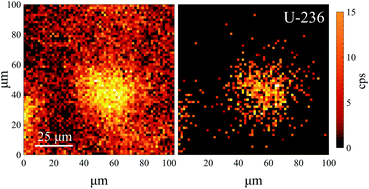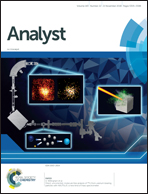Direct, uncorrected, molecule-free analysis of 236U from uranium-bearing particles with NAUTILUS: a new kind of mass spectrometer
Abstract
We demonstrate use of the Naval Ultra-Trace Isotope Laboratory's Universal Spectrometer (NAUTILUS) at the U.S. Naval Research Laboratory (NRL) to measure 236U directly from uranium-bearing particles free from molecular isobaric interferences. Particles with 235U enrichments in the range of 0.32% to 3.28% and 236U enrichments from no enrichment to 0.015% provided by the International Atomic Energy Agency (IAEA) were analyzed directly using the NAUTILUS. We report the experimental data here without correcting for molecular hydrides and/or applying any other background subtractions. The results from all samples agreed with the certified values within standard error save for the 236U composition of the IRMM 023, which suffered from a combination of insufficient particle sizes and sub-μmol mol−1 236U concentrations. We were able, however, to directly measure as low as three μmol mol−1 of 236U in individual particles regardless of the 235U concentration. Our results are comparable with Large Geometry Secondary Ion Mass Spectrometry (LG-SIMS) and serve as baseline for a more comprehensive comparison between LG-SIMS and the NAUTILUS in the future. Moreover, we demonstrate the ability of the NAUTILUS to generate raster ion images with the same ease as traditional LG-SIMS instruments. By combining our ability to measure 236U directly with raster ion imaging, we were able to detect a low intensity, small uranium-bearing particle in the presence of high molecular backgrounds for a non-ideal sample. This discovery could lead to more targeted and, therefore, less time intensive particle screening methodologies.



 Please wait while we load your content...
Please wait while we load your content...
